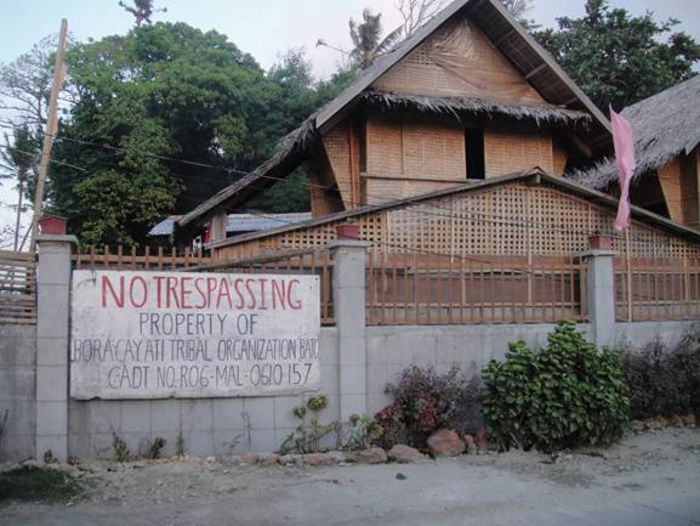Boracay is a 1,032-hectare island paradise of cerulean beaches, and a prime tourism destination in the Philippines. It is home to an Ati indigenous community comprised of no fewer than 250 individuals. Unfettered tourism development drove the Ati to the Boracay’s hinterlands, and led to the temporary closure of the Island to tourists to prevent further environmental damage. Whether this drastic measure will turn the tide towards sustainable tourism policies that respect the Ati’s rights remains to be seen.
The rise of tourism on Boracay
The Ati are descended from the first habitants of the Philippines. Traditionally, the Ati were semi-nomadic hunter-gatherers who roamed the island in small bands, stayed temporarily in viable hunting grounds, and moved back to the environs that they considered as home.
The influx of Filipino non-Ati migrants at the turn of the century, and the onset of an extensive tourism development policy promoted by the government in the 1970s forced the Ati to relocate to the Island’s more remote areas. They did not possess legal documents to prove their occupation, much less ownership, of their ancestral lands. By the early 2000s, the government and non-Ati land claimants treated the Ati as informal settlers and threatened them with eviction. This is unsurprising, as the value of real estate and investments in Boracay were on the rise, just as its popularity as a tourist attraction was gaining traction.
Despite the Ati’s ownership of their ancestral territories based on native title, their claim was vulnerable to challenges both by the State and private land claimants, as they could not prove their claim with document titles. Thus, the Ati were compelled to bolster their claim by obtaining a Certificate of Ancestral Domain Title (CADT), which under the Indigenous Peoples’ Rights Act of 1997 (IPRA), is an optional, rather than a mandatory process for State recognition of native titles.
Fighting for their lands and lives
Tourism enterprises, the local government, and national agencies, claimed that the Ati were illegally occupying private property and asserting their native title over State-owned land. They tried to convince the Ati Community of Boracay Island to abandon their application, and move to an Ati settlement in Aklan Province. The Community persevered with its application, but only laid claim over a small area in Boracay in which they could live. In 2001, the Ati emphasised the urgency behind their application for a CADT in a letter addressed to the National Commission on Indigenous Peoples:
In connection with the rapid spread of tourism “for the sake of development” and the reported plans of other people to own land here in Boracay… as well as the granting of land titles by various government agencies, we are appealing that our petition be heard as soon as possible, before we totally lose our land, heritage, rights, our very LIVES here in our ancestral domain. We long only for this piece of land to bestow on our children, to spare them from the hardship and misery and uncertainty that we are suffering.
The struggle continues
It took more than decade for the Ati to obtain their CADT over 2.1 hectares of land – less than one percent of the entire Island – and over a year to finally occupy some areas of their ancestral domains. Their struggles, however, are far from over. Migrant land claimants continue to challenge their rights with lawsuits that are still pending. Moreover, the Ati are still unable to occupy the entire 2.1 hectares of their ancestral domains because claimants refuse to vacate some areas. The conflicts over land led to violence, such as the killing of the Ati’s spokesperson, Dexter Condez in 2013. Justice for Dexter and the Ati Community remains elusive.
Tourism: both a blessing and a curse
The Ati were granted an additional 3.2 hectares of land in Boracay in November 2018, following a six-month closure of the island to tourists for its environmental rehabilitation. The land was conferred to the Ati outside the rubric of the IPRA, and not in recognition of their ownership of land by virtue of their native title, but as a gratuity to farmer beneficiaries of State-owned land. Government plans are underway for the land to be used for Ati residences, and for agro-tourism initiatives that will be managed by the Community. Nevertheless, the Ati are bracing themselves, as some claimants have warned them of backlash for their temerity to assert ownership over even more land in Boracay.
The Ati’s relationship with the tourism industry is ambivalent at best: While 80 percent of its members find low skilled work in tourism establishments and they welcome tourists to the heritage centre in their village, they still see Boracay’s burgeoning tourism industry as a threat to their land tenure and culture. The Ati continue to grapple with discrimination, and the fear that their ancestral domains are still at the risk of usurpation or sale to the highest bidder.
Dr. Mary Kristerie A. Baleva is the author of Regaining Paradise Lost: Indigenous Land Rights and Tourism, where she used the UN Guiding Principles on Business and Human Rights as the overarching framework to analyze the intersections of indigenous land rights and the tourism industry. She completed her LL.M and Ph.D., both in human rights law, at the University of Kong, and the University of Zurich, respectively.


